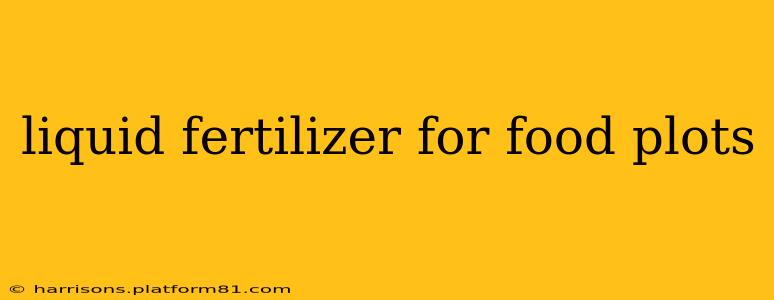Liquid fertilizers are becoming increasingly popular for food plots, offering several advantages over granular options. This comprehensive guide explores the benefits, application methods, and considerations for using liquid fertilizer to maximize your food plot success. We'll delve into frequently asked questions to ensure you have all the information you need to make informed decisions.
Why Choose Liquid Fertilizer for Food Plots?
Liquid fertilizers boast several advantages that make them a compelling choice for food plot management. Their fast-acting nature allows for rapid nutrient uptake by plants, leading to quicker establishment and growth. This is particularly crucial in shorter growing seasons. Furthermore, liquid applications offer greater flexibility, allowing for targeted nutrient delivery to specific areas or plants needing a boost. The precise application minimizes waste compared to granular fertilizers, which can be lost through runoff or wind. Finally, liquid fertilizers are often easier to handle and apply, especially over large areas, saving time and effort.
What are the Different Types of Liquid Fertilizer for Food Plots?
Several types of liquid fertilizers are suitable for food plots, each offering unique nutrient profiles and benefits. These often include:
- Nitrogen (N): Essential for vigorous growth and leaf development. Look for liquid nitrogen sources like urea-ammonium nitrate solutions.
- Phosphorus (P): Crucial for root development, flowering, and seed production. Liquid phosphate fertilizers are readily available.
- Potassium (K): Vital for overall plant health, disease resistance, and stress tolerance. Liquid potassium fertilizers contribute to strong stems and improved winter hardiness.
- Complete Fertilizers: These contain a balanced blend of NPK (Nitrogen, Phosphorus, Potassium) and often include secondary nutrients like sulfur, magnesium, and micronutrients essential for optimal plant health. The specific NPK ratio should be selected based on the soil test results and the target plant species.
The best type of liquid fertilizer for your food plot will depend on factors such as your soil test results, the specific plants you're growing, and your budget.
How Do I Apply Liquid Fertilizer to My Food Plot?
Applying liquid fertilizer effectively requires the right equipment and technique. Common application methods include:
- Sprayers: A calibrated sprayer, whether backpack, ATV-mounted, or tractor-pulled, ensures even distribution. Accurate calibration is vital to avoid over- or under-application.
- Injection Systems: These are less common but offer precise placement of the fertilizer directly into the soil.
- Fertigation: This involves injecting fertilizer into irrigation systems, providing a controlled and efficient application method, especially beneficial in larger plots.
Always follow the manufacturer's instructions carefully for application rates and safety precautions. Applying liquid fertilizer during periods of moderate moisture and avoiding windy days will maximize effectiveness and minimize nutrient loss.
What are the Benefits of Using Liquid Fertilizer Over Granular?
As mentioned earlier, liquid fertilizers offer several key advantages:
- Faster Nutrient Uptake: Plants absorb nutrients quickly, resulting in faster growth.
- Targeted Application: Allows for precise placement of nutrients, maximizing efficiency and minimizing waste.
- Ease of Application: Generally easier to handle and apply than granular fertilizers, especially in larger areas.
- Improved Nutrient Use Efficiency: Reduces nutrient losses compared to granular fertilizers due to leaching or volatilization.
What is the Best Time to Apply Liquid Fertilizer to a Food Plot?
The optimal timing for liquid fertilizer application varies depending on the plant species, growing season, and soil conditions. However, general guidelines include:
- Pre-Planting: Applying fertilizer before planting ensures nutrients are readily available as the seeds germinate and begin to grow.
- During Active Growth: Applying fertilizer during peak growing periods supports optimal plant development.
- Split Applications: Multiple smaller applications throughout the growing season often yield better results than one large application.
How Often Should I Apply Liquid Fertilizer to My Food Plot?
The frequency of application depends on several factors including soil test results, plant requirements, and weather conditions. Regular soil testing is crucial to monitor nutrient levels and adjust application rates accordingly. Following the manufacturer's recommendations and consulting with local agricultural experts can provide tailored advice.
What Safety Precautions Should I Take When Using Liquid Fertilizer?
Liquid fertilizers can be hazardous if mishandled. Always follow these safety precautions:
- Wear protective gear: This includes gloves, eye protection, and appropriate clothing.
- Handle with care: Avoid spilling or splashing the fertilizer.
- Store properly: Store fertilizers in a cool, dry, and well-ventilated area away from children and pets.
- Follow label instructions: Pay close attention to application rates, safety warnings, and disposal procedures.
By carefully considering these factors and employing best practices, you can effectively utilize liquid fertilizers to cultivate thriving and productive food plots. Remember, consistent monitoring and adaptation are key to achieving optimal results.
